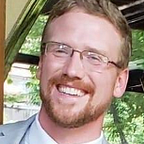My Pragmatic Journey to Voice & Choice in the Classroom
Author’s Note: This article was originally written and published in August 2018, it is re-published here for the Human Restoration Project. I’m excited and honored to be joining the Human Restoration Project as a contributor; to be able to share in this most important work of making classrooms and schools healthy, reflective, responsive places of partnership. This article initiates my perspective as a public school classroom teacher and how I half-stumbled into progressive practices that transformed my relationships with students and to the content I was tasked to teach. Later in this series I’ll unpack “Cutting Content to Make Room for Learning — Our PBL Future” and “What Senior Year Could Be”. Thanks for reading, let’s restore humanity together!
I thought I was doing everything “right”.
I had prided myself on unpacking standards, planning engaging, performative lessons and units that were well-paced and tech savvy; putting together complicated, ambitious projects and writing prompts with standards-referenced, multiple-tiered rubrics and criteria for students to meet or exceed.
Yet my journey to student voice and choice in the classroom was born out of an intense frustration that what I and my co-teacher were spending hours planning, and daily troubleshooting, just wasn’t having the impact we were intending. Students frustrated with technology, bored with a topic, or just not feeling like learning about the Reformation for three weeks would act out, speak out, lash out, just anything to get away from a classroom that, now, so obviously demanded that students care and learn about and think important what I, an adult with a history degree and a shelf full of history books, cared and found important and demanded they learn about.
But they didn’t care and didn’t think it was important and they weren’t learning (which is kind of the point of teaching) and by October I went home almost every night wondering if I was going to be a casualty of fifth-year teacher burnout. So out of that frustration I did what every tired parent has done in a moment of exhaustion and said “Fine, what do YOU want to do?!”, and it turned out to be the most important decision of my teaching career:
It turns out that, if you let them, students will partner with their peers to research, create, and send a presentation to the school board about Eurocentrism in our history curriculum (and fume over the board’s complacent response).
Students will interview a local funeral director and present to the class a history of American attitudes toward death, dying, and an overview on the science of embalming and preservation, if you let them. (the same student later presented on existentialism and Jean-Paul Sartre and read from Nausea in French and English so we could hear it in the original language)
Students will teach a lesson to their peers about the technological advances of the Roaring 20s, complete with a pre- and post-quiz Kahoot to demonstrate their classmate’s learning, if you let them.
Students will blog openly about controversial and deeply personal topics, post their work to an online audience, and solicit feedback from friends and strangers alike, if you let them.
“What do you want to do?” was followed by “How are you going to do it?” and “With whom?” which was then followed by “For whom?”, “What will the impact be?”, “What tools or resources will you need?”, and “How will you know when you’ve gotten there?”
This kind of problem-solving questioning is how I learned to make molasses cookies and the same line of questioning that put human beings on the Moon. Too often, student voice and choice is singled out as an idealistic pedagogy, but it turns out that this simple set of questions can be used as a lens to look at almost any issue, topic, or problem imaginable, and with that set of questions came the simple but powerful permission to imagine.
I couldn’t let grading and evaluating and points and what was exceeding versus meeting and not-quite-there-yet interfere with deep, meaningful student learning because it didn’t matter what the rubric said or what the levels were: students were more motivated to learn, were more engaged in their learning, and sharing in their learning together in a way that hadn’t existed in my classroom before.
So how did I grade all of this? Well, I didn’t, really. I didn’t need to, and I couldn’t let grading and evaluating and points and what was exceeding-versus meeting-and-not-quite-there-yet interfere with deep, meaningful student learning because it didn’t matter what the rubric said or what the levels were: students were more motivated to learn, were more engaged in their learning, and sharing in their learning together in a way that hadn’t existed in my classroom before. I went from being a micromanager of student behaviors directed at teacher-focused outcomes, dreading each class period and waiting to see how these students could screw up my lesson plan, to a learning partner, sharing in the joy of learning with students, talking openly with them about their learning with no evaluative agenda, and learning alongside and from them as a result. I did less, students did and learned more; we were happier and had a healthier classroom culture.
I did less, students did and learned more; we were happier and had a healthier classroom culture.
